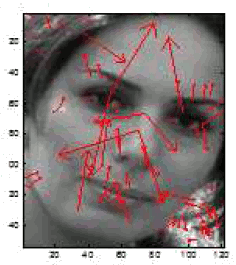Gender Recognition
August 22, 2011
Desk Set (1957, Walter Lang, Director), is an enjoyable film staring
Spencer Tracy and
Katharine Hepburn. My wife and I include this in our
Christmas holiday home film festival because of the memorable Christmas scenes. The film is interesting to
computer people because of the completely fanciful depiction of
mainframe computers and their operation in the late 1950s.
Tracy, who is portrayed as a "
methods engineer," actually plays something like a
computer scientist who's been assigned to computerize a
library. He's instructed not to tell the library staff, including head librarian, Hepburn, about this for fear that the change would diminish employee morale. They find out on the big day when the EMARAC machine is installed.
EMARAC, which sounds like
ENIAC, was the Electromagnetic Memory and Research Arithmetical Calculator. It had
natural language processing that's magical even by today's computing standards. The ENIAC-like name is all the more interesting because the filmmakers "gratefully acknowledge the cooperation and assistance of the
International Business Machines Corporation." ENIAC was the predecessor of the
UNIVAC product line, an IBM competitor.
For no apparent reason, Tracy gives Hepburn an
IQ test during a luncheon date. Here's one question from that test.
Tracy:
"Often, when we meet people for the first time, some physical characteristic strikes us. Now, what is the first thing you notice in a person?"
Hepburn:
"Whether the person is male or female."
Our ability to distinguish between male and female faces is remarkable. I can say without possibility of being contradicted that this ability has an
evolutionary advantage. Why, exactly, are male faces so distinguishable from female? It's hard to say. According to one reference,
"... Neurologically intact humans do recognize sex from face. But by and large they are unable to say how. Although certain features are nearly pathognomonic for one sex or the other (facial hair for men, makeup or certain hairstyles for women), even in the absence of these cues the determination is made; and even in their presence, other cues may override."[1]

La nascita di Venere (Birth of Venus) by Sandro Botticelli
Venus is an icon of female beauty, but it's hard to fix your gaze only on her face.
(Via Wikimedia Commons))
Facial recognition systems have improved sharply over the last few years. A
Face Recognition Grand Challenge, sponsored in 2006 by
NIST, showed a nearly
exponential increase in accuracy with time, with ten-fold increases happening on a five year time scale.[2] Of course, much of this can be attributed to the very poor performance of the initial systems, but algorithms can now outperform humans in facial recognition, and they can even identify
identical twins.
Computer scientists can code for anything, as long as they have the fundamental idea. In a search for things that distinguish faces, computer scientists have been examining the
caricature process.[3-4] A caricature artist knows which features to emphasize on a face to make that face an exaggerated representation of the person that's still recognizable. MIT's
Sinha Laboratory for Vision Research studied caricature to produce a list of the most important attributes in facial recognition.[3]
The MIT research showed that ratios of distances between features in the vertical dimension, and features in the horizontal dimension, are important, but not ratios between vertical and horizontal components. In the vertical direction, one of these is the ratio of the height of the forehead to the distance between the top of the nose and the mouth.[3] There is nearly complete independence of vertical and horizontal facial components, so that the height and width of a face can be independently scaled without affecting recognizability that much.[4]
Returning to our original topic of gender detection, Sahar Yousefi and Morteza Zahedi of the School of Technology and Computer Engineering,
Shahrood University of Technology,
Shahrood, Iran, have reported on a gender classification method they say is computationally less intensive than previous methods.[5]
Previous methods required a preprocessing step in which facial landmarks, such as eyes, nose, lips and chin, are mapped to uniform image locations. Yousefi and Zahedi's technique takes a simplistic approach of first detecting a face by color. This is followed by a technique called
scale invariant feature transform (SIFT),[6] and a supervised learning technique for
pattern classification and regression.
They collected a database of 500 images from 500 distinct people, split 50:50 by gender (A smaller public database, useful for other image processing tests, contains ten different images of forty distinct subjects under different conditions[7]). These 500 images had different facial expressions, and they were made under different lighting conditions. Their simplified method gave a gender recognition rate of 87%.[5]
More impressive is
this YouTube video of unknown provenance, but apparently
Russian, which purports to show gender recognition using "pattern maps."[8] New techniques are continually published.[9]

Keypoint vectors, drawn on a female facial image, defining 72 keypoints.
From Sahar Yousefi and Morteza Zahedi, "Gender Recognition Based on SIFT Features."
(arXiv Preprint Server) [5]
There are
privacy concerns as facial recognition is now used in
surveillance, and as a classification method for images on
social networking sites.
Carnegie Mellon's Data Privacy Laboratory has a unique solution for privacy protection of images that individuals may wish to release without having faces identified. Instead of just putting a black circle over the face, the CMU researchers developed a way to substitute actual facial images with synthesized facial images.[10]
If you're a woman, then privacy protection
makeup may be the answer.[11-12]
How could I write an article about
digital image processing without a mention of
Lenna? If you're not in the image processing community, you may not know about her.[13]
References:
- B. Golomb and T. Sejnowski, "Sex Recognition from Faces Using Neural Networks," Chapter 3 of A. Murray, Ed., "Applications of Neural Networks," (Kluwer Academic Publishers, 1995), pp. 71-92.
- Face Recognition Grand Challenge (FRGC), The National Institute of Standards and Technology, U.S. Department of Commerce, February 15, 2011.
- Ben Austen, "What Caricatures Can Teach Us About Facial Recognition," Wired, July 15, 2011.
- Pawan Sinha, "The Far Side," PowerPoint presentation, MIT Department of Brain and Cognitive Sciences.
- Sahar Yousefi and Morteza Zahedi, "Gender Recognition Based on SIFT Features," arXiv Preprint Server, August 6, 2011.
- Lowe David G. Lowe, "Object Recognition from Local Scale-Invariant Features," Proceedings of the Seventh IEEE International Conference on Computer Vision, vol. 2 (1999), pp. 1150-1157.
- AT&T Laboratories- Cambridge, Database of Faces.
- Gender Recognition Using Pattern Maps, YouTube video.
- J. Bekios-Calfa, J.M. Buenaposada and L. Baumela, "Revisiting Linear Discriminant Techniques in Gender Recognition," IEEE Transactions on Pattern Analysis and Machine Intelligence, vol. 33, no. 4 (April, 2011), pp. 858-864.
- Mark Williams, "Better Face-Recognition Software," Technology Review, May 30, 2007.
- Bruce Schneier, "Developments in Facial Recognition," August 2, 2011.
- Kim-Mai Cutler, "How to camouflage yourself from facial recognition technology," Venture Beat, July 2, 2010
- The Lenna Story at www.lenna.org.
Permanent Link to this article
Linked Keywords: Desk Set; Spencer Tracy; Katharine Hepburn; Christmas; computer people; mainframe computers; methods engineer; computer scientist; library; ENIAC; natural language processing; IBM; International Business Machines Corporation; UNIVAC; intelligence quotient; IQ test; evolutionary advantage; Venus Anadyomene; Birth of Venus; Sandro Botticelli; Venus; Wikimedia Commons; Facial recognition system; Face Recognition Grand Challenge; National Institute of Standards and Technology; NIST; exponential function; identical twins; caricature; Sinha Laboratory for Vision Research; Shahrood University of Technology; Shahrood, Iran; scale invariant feature transform; pattern classification and regression; YouTube video; Russian; arXiv Preprint Server; privacy; surveillance; social network; Carnegie Mellon; Data Privacy Laboratory; cosmetics; makeup; digital image processing; Lenna.